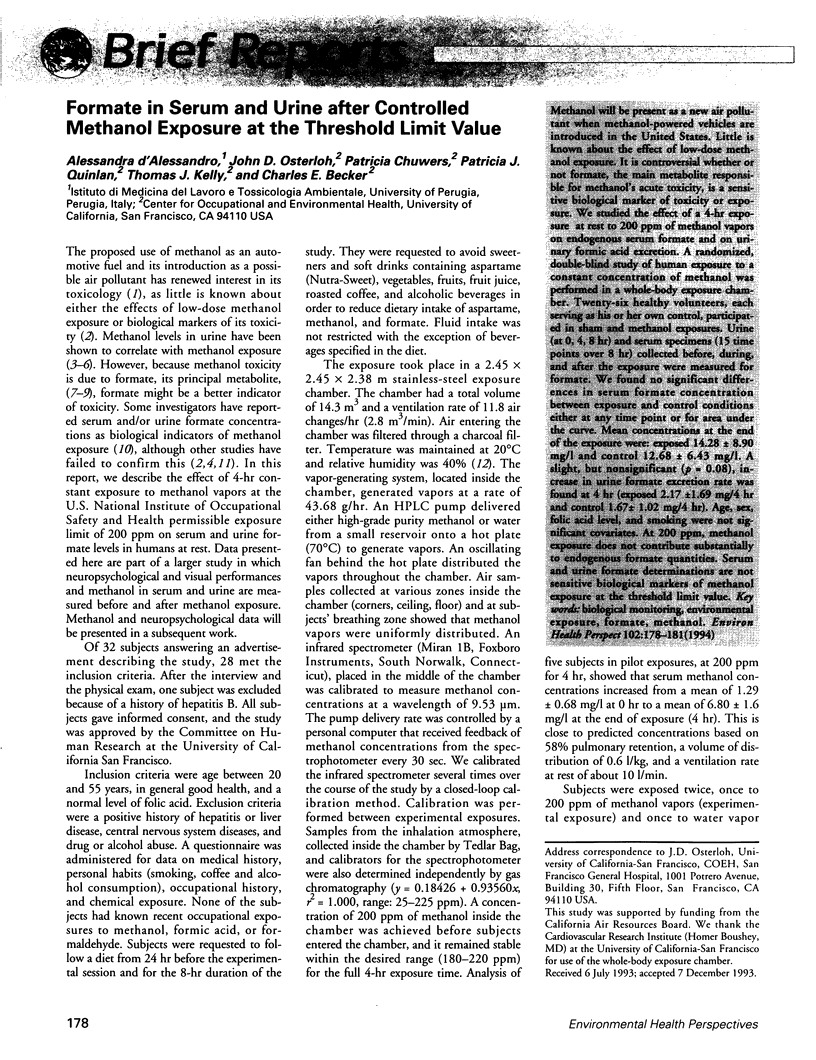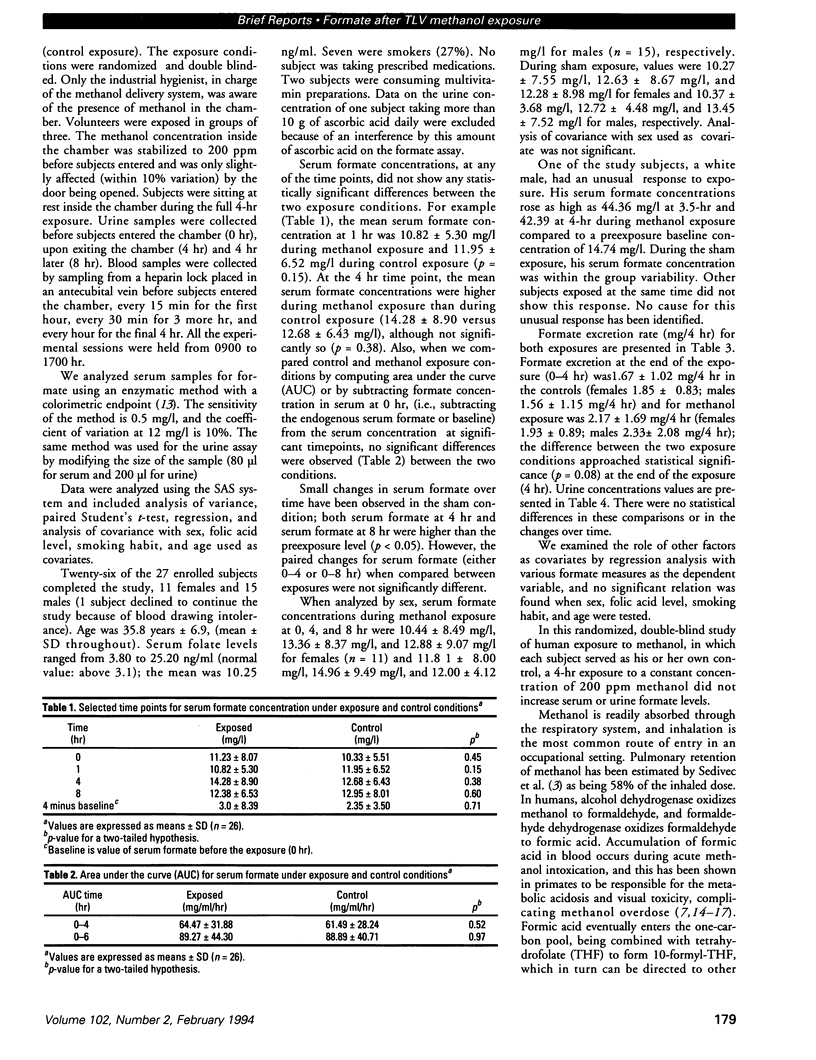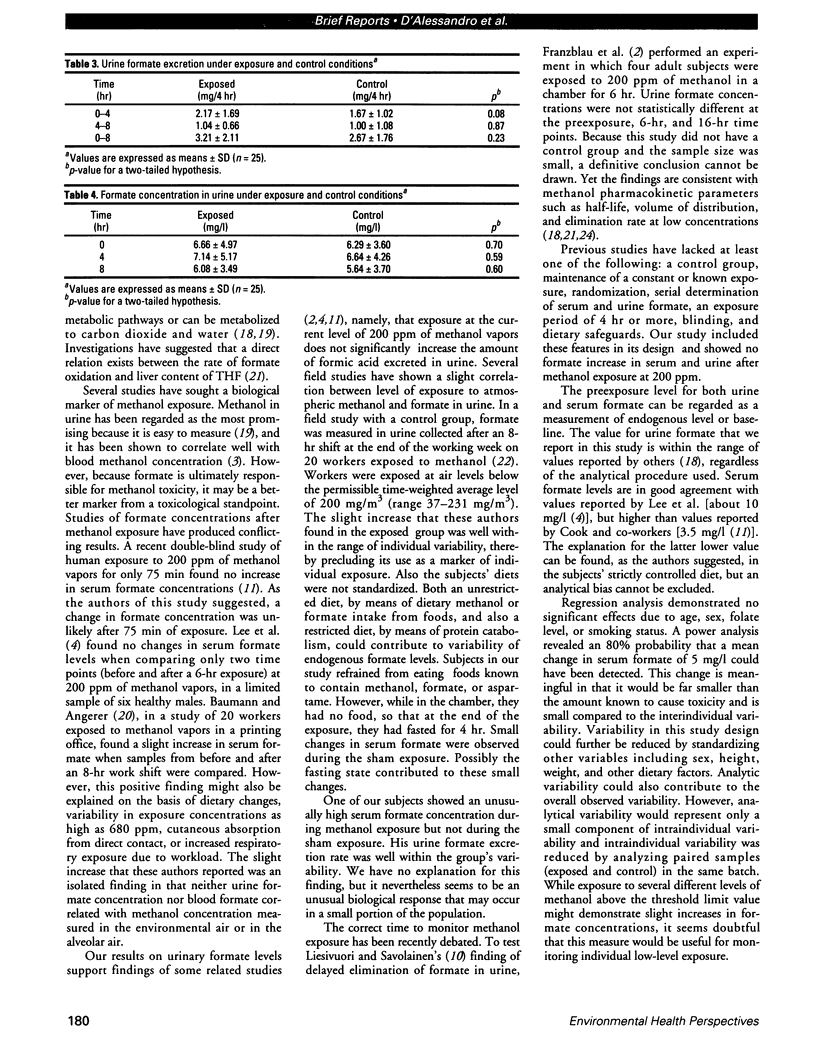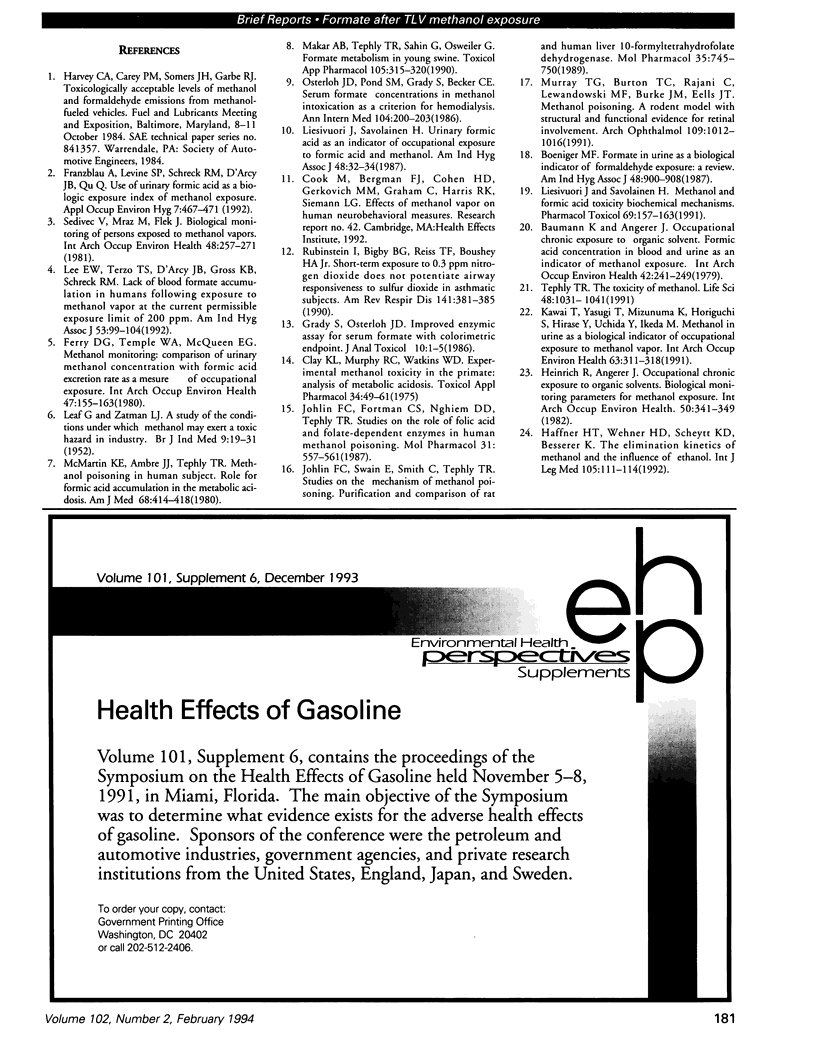Abstract
Methanol will be present as a new air pollutant when methanol-powered vehicles are introduced in the United States. Little is known about the effect of low-dose methanol exposure. It is controversial whether or not formate, the main metabolite responsible for methanol's acute toxicity, is a sensitive biological marker of toxicity or exposure. We studied the effect of a 4-hr exposure at rest to 200 ppm of methanol vapors on endogenous serum formate and on urinary formic acid excretion. A randomized, double-blind study of human exposure to a constant concentration of methanol was performed in a whole-body exposure chamber. Twenty-six healthy volunteers, each serving as his or her own control, participated in sham and methanol exposures. Urine (at 0, 4, 8 hr) and serum specimens (15 time points over 8 hr) collected before, during, and after the exposure were measured for formate. We found no significant differences in serum formate concentration between exposure and control conditions either at any time point or for area under the curve. Mean concentrations at the end of the exposure were: exposed 14.28 +/- 8.90 mg/l and control 12.68 +/- 6.43 mg/l. A slight, but nonsignificant (p = 0.08), increase in urine formate excretion rate was found at 4 hr (exposed 2.17 +/- 1.69 mg/4 hr and control 1.67 +/- 1.02 mg/4 hr). Age, sex, folic acid level, and smoking were not significant covariates. At 200 ppm, methanol exposure does not contribute substantially to endogenous formate quantities. Serum and urine formate determinations are not sensitive biological markers of methanol exposure at the threshold limit value.
Full text
PDF



Images in this article
Selected References
These references are in PubMed. This may not be the complete list of references from this article.
- Baumann K., Angerer J. Occupational chronic exposure to organic solvents. VI. Formic acid concentration in blood and urine as an indicator of methanol exposure. Int Arch Occup Environ Health. 1979 Jan 15;42(3-4):241–249. doi: 10.1007/BF00377778. [DOI] [PubMed] [Google Scholar]
- Boeniger M. F. Formate in urine as a biological indicator of formaldehyde exposure: a review. Am Ind Hyg Assoc J. 1987 Nov;48(11):900–908. doi: 10.1080/15298668791385787. [DOI] [PubMed] [Google Scholar]
- Clay K. L., Murphy R. C., Watkins W. D. Experimental methanol toxicity in the primate: analysis of metabolic acidosis. Toxicol Appl Pharmacol. 1975 Oct;34(1):49–61. doi: 10.1016/0041-008x(75)90174-x. [DOI] [PubMed] [Google Scholar]
- Ferry D. G., Temple W. A., McQueen E. G. Methanol monitoring. Comparison of urinary methanol concentration with formic acid excretion rate as a measure of occupational exposure. Int Arch Occup Environ Health. 1980;47(2):155–163. doi: 10.1007/BF00716374. [DOI] [PubMed] [Google Scholar]
- Haffner H. T., Wehner H. D., Scheytt K. D., Besserer K. The elimination kinetics of methanol and the influence of ethanol. Int J Legal Med. 1992;105(2):111–114. doi: 10.1007/BF02340834. [DOI] [PubMed] [Google Scholar]
- Heinrich R., Angerer J. Occupational chronic exposure to organic solvents. X. Biological monitoring parameters for methanol exposure. Int Arch Occup Environ Health. 1982;50(4):341–349. doi: 10.1007/BF00377830. [DOI] [PubMed] [Google Scholar]
- Johlin F. C., Fortman C. S., Nghiem D. D., Tephly T. R. Studies on the role of folic acid and folate-dependent enzymes in human methanol poisoning. Mol Pharmacol. 1987 May;31(5):557–561. [PubMed] [Google Scholar]
- Johlin F. C., Swain E., Smith C., Tephly T. R. Studies on the mechanism of methanol poisoning: purification and comparison of rat and human liver 10-formyltetrahydrofolate dehydrogenase. Mol Pharmacol. 1989 Jun;35(6):745–750. [PubMed] [Google Scholar]
- Kawai T., Yasugi T., Mizunuma K., Horiguchi S., Hirase Y., Uchida Y., Ikeda M. Methanol in urine as a biological indicator of occupational exposure to methanol vapor. Int Arch Occup Environ Health. 1991;63(5):311–318. doi: 10.1007/BF00381580. [DOI] [PubMed] [Google Scholar]
- LEAF G., ZATMAN L. J. A study of the conditions under which methanol may exert a toxic hazard in industry. Br J Ind Med. 1952 Jan;9(1):19–31. doi: 10.1136/oem.9.1.19. [DOI] [PMC free article] [PubMed] [Google Scholar]
- Lee E. W., Terzo T. S., D'Arcy J. B., Gross K. B., Schreck R. M. Lack of blood formate accumulation in humans following exposure to methanol vapor at the current permissible exposure limit of 200 ppm. Am Ind Hyg Assoc J. 1992 Feb;53(2):99–104. doi: 10.1080/15298669291359357. [DOI] [PubMed] [Google Scholar]
- Liesivuori J., Savolainen H. Methanol and formic acid toxicity: biochemical mechanisms. Pharmacol Toxicol. 1991 Sep;69(3):157–163. doi: 10.1111/j.1600-0773.1991.tb01290.x. [DOI] [PubMed] [Google Scholar]
- Liesivuori J., Savolainen H. Urinary formic acid as an indicator of occupational exposure to formic acid and methanol. Am Ind Hyg Assoc J. 1987 Jan;48(1):32–34. doi: 10.1080/15298668791384328. [DOI] [PubMed] [Google Scholar]
- Makar A. B., Tephly T. R., Sahin G., Osweiler G. Formate metabolism in young swine. Toxicol Appl Pharmacol. 1990 Sep 1;105(2):315–320. doi: 10.1016/0041-008x(90)90192-w. [DOI] [PubMed] [Google Scholar]
- McMartin K. E., Ambre J. J., Tephly T. R. Methanol poisoning in human subjects. Role for formic acid accumulation in the metabolic acidosis. Am J Med. 1980 Mar;68(3):414–418. doi: 10.1016/0002-9343(80)90113-8. [DOI] [PubMed] [Google Scholar]
- Murray T. G., Burton T. C., Rajani C., Lewandowski M. F., Burke J. M., Eells J. T. Methanol poisoning. A rodent model with structural and functional evidence for retinal involvement. Arch Ophthalmol. 1991 Jul;109(7):1012–1016. doi: 10.1001/archopht.1991.01080070124049. [DOI] [PubMed] [Google Scholar]
- Osterloh J. D., Pond S. M., Grady S., Becker C. E. Serum formate concentrations in methanol intoxication as a criterion for hemodialysis. Ann Intern Med. 1986 Feb;104(2):200–203. doi: 10.7326/0003-4819-104-2-200. [DOI] [PubMed] [Google Scholar]
- Rubinstein I., Bigby B. G., Reiss T. F., Boushey H. A., Jr Short-term exposure to 0.3 ppm nitrogen dioxide does not potentiate airway responsiveness to sulfur dioxide in asthmatic subjects. Am Rev Respir Dis. 1990 Feb;141(2):381–385. doi: 10.1164/ajrccm/141.2.381. [DOI] [PubMed] [Google Scholar]
- Sedivec V., Mráz M., Flek J. Biological monitoring of persons exposed to methanol vapours. Int Arch Occup Environ Health. 1981;48(3):257–271. doi: 10.1007/BF00405613. [DOI] [PubMed] [Google Scholar]
- Tephly T. R. The toxicity of methanol. Life Sci. 1991;48(11):1031–1041. doi: 10.1016/0024-3205(91)90504-5. [DOI] [PubMed] [Google Scholar]



